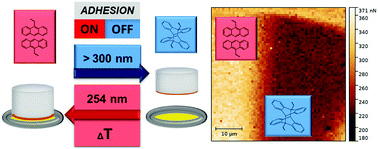当前位置:
X-MOL 学术
›
Soft Matter
›
论文详情
Our official English website, www.x-mol.net, welcomes your
feedback! (Note: you will need to create a separate account there.)
Switching “on” and “off” the adhesion in stimuli-responsive elastomers†
Soft Matter ( IF 2.9 ) Pub Date : 2018-03-06 00:00:00 , DOI: 10.1039/c8sm00284c S. Kaiser 1, 2, 3 , S. V. Radl 1, 2, 3 , J. Manhart 1, 2, 3 , S. Ayalur-Karunakaran 1, 2, 3 , T. Griesser 2, 3, 4, 5, 6 , A. Moser 2, 3, 7 , C. Ganser 2, 3, 6, 8 , C. Teichert 2, 3, 6, 8 , W. Kern 1, 2, 3, 5, 6 , S. Schlögl 1, 2, 3
Soft Matter ( IF 2.9 ) Pub Date : 2018-03-06 00:00:00 , DOI: 10.1039/c8sm00284c S. Kaiser 1, 2, 3 , S. V. Radl 1, 2, 3 , J. Manhart 1, 2, 3 , S. Ayalur-Karunakaran 1, 2, 3 , T. Griesser 2, 3, 4, 5, 6 , A. Moser 2, 3, 7 , C. Ganser 2, 3, 6, 8 , C. Teichert 2, 3, 6, 8 , W. Kern 1, 2, 3, 5, 6 , S. Schlögl 1, 2, 3
Affiliation

|
The present work aims at the preparation of dry adhesives with switchable bonding properties by using the reversible nature of the [4πs+4πs] cycloaddition of anthracenes. Photo-responsive hydrogenated carboxylated nitrile butadiene rubber with photo-responsive pendant anthracene groups is prepared by one-pot synthesis. The formation of 3D networks relies on the photodimerization of the anthracene moieties upon UV exposure (λ > 300 nm). Controlled cleavage of the crosslink sites is achieved by either deep UV exposure (λ = 254 nm) or thermal dissociation at 70 °C. The kinetics of the optical and thermal cleavage routes are compared in thin films using UV-vis spectroscopy and their influence on the reversibility of the network is detailed. Going from thin films to free standing samples the modulation of the network structure and thermo-mechanical properties over repeated crosslinking and cleavage cycles are characterized by low-field NMR spectroscopy and dynamic mechanical analysis. The applicability of the stimuli-responsive networks as adhesives with reversible bonding properties is demonstrated. The results evidence that the reversibility of the crosslinking reaction enables a controlled switching “on” and “off” of adhesion properties. The recovery of the adhesion force amounts to 75 and 80% for photo- and thermal dissociation, respectively. Spatial control of adhesion properties is evidenced by adhesion force mapping experiments of photo-patterned films.
中文翻译:

切换“打开”和“关闭”刺激敏感弹性体的附着力†
本工作旨在通过利用蒽的[4πs+4πs]环加成反应的可逆性来制备具有可切换粘合性能的干胶。通过一锅合成法制备具有光响应性蒽侧基的光响应性氢化羧化丁腈橡胶。3D网络的形成依赖于紫外线照射(λ > 300 nm)时蒽部分的光二聚作用。交联位点的可控制裂解可通过深紫外线照射(λ= 254 nm)或70°C时的热解离。使用紫外-可见光谱法比较了薄膜中光学和热裂解途径的动力学,并详细说明了它们对网络可逆性的影响。从薄膜到独立样品,网络结构和热机械性能在反复交联和裂解循环过程中的调制通过低场NMR光谱学和动态力学分析来表征。证明了刺激响应网络作为具有可逆粘合特性的粘合剂的适用性。结果证明,交联反应的可逆性使得粘合性能的受控接通“接通”和“断开”成为可能。对于光解离和热解离,粘附力的恢复分别达到75%和80%。
更新日期:2018-03-06
中文翻译:

切换“打开”和“关闭”刺激敏感弹性体的附着力†
本工作旨在通过利用蒽的[4πs+4πs]环加成反应的可逆性来制备具有可切换粘合性能的干胶。通过一锅合成法制备具有光响应性蒽侧基的光响应性氢化羧化丁腈橡胶。3D网络的形成依赖于紫外线照射(λ > 300 nm)时蒽部分的光二聚作用。交联位点的可控制裂解可通过深紫外线照射(λ= 254 nm)或70°C时的热解离。使用紫外-可见光谱法比较了薄膜中光学和热裂解途径的动力学,并详细说明了它们对网络可逆性的影响。从薄膜到独立样品,网络结构和热机械性能在反复交联和裂解循环过程中的调制通过低场NMR光谱学和动态力学分析来表征。证明了刺激响应网络作为具有可逆粘合特性的粘合剂的适用性。结果证明,交联反应的可逆性使得粘合性能的受控接通“接通”和“断开”成为可能。对于光解离和热解离,粘附力的恢复分别达到75%和80%。











































 京公网安备 11010802027423号
京公网安备 11010802027423号